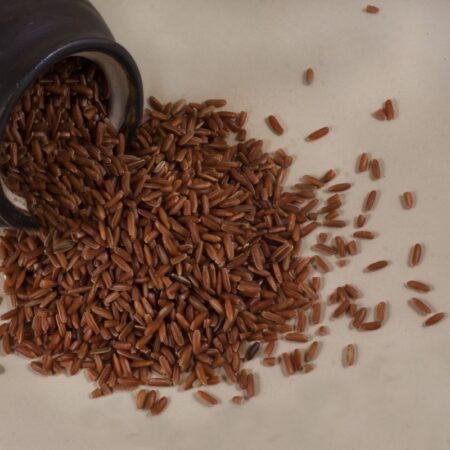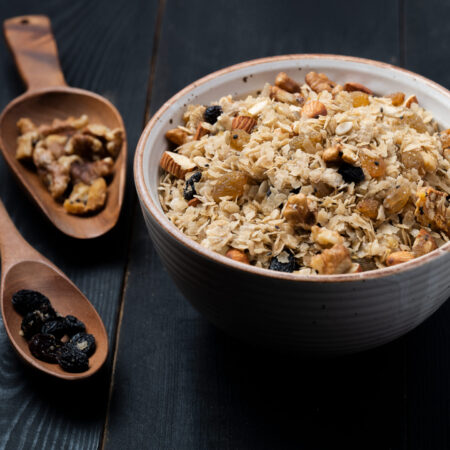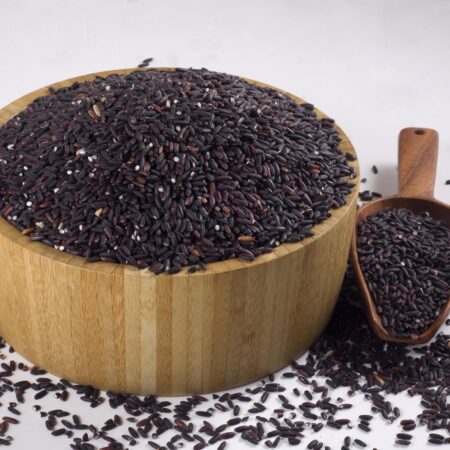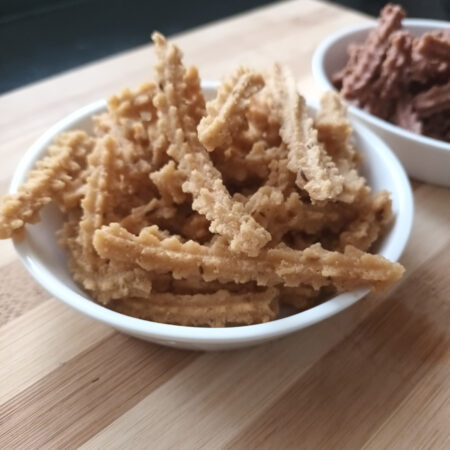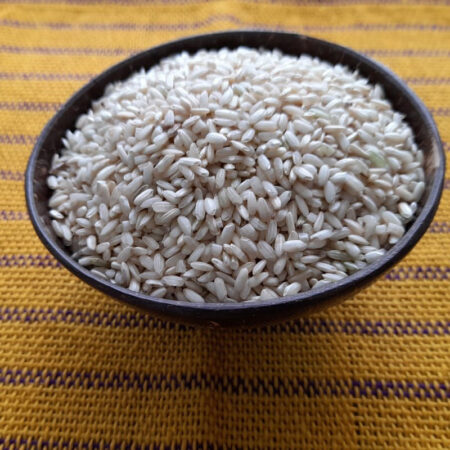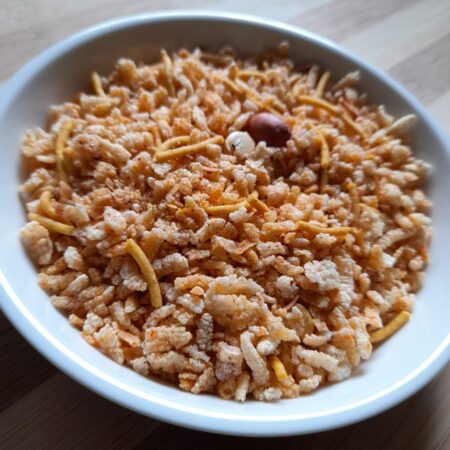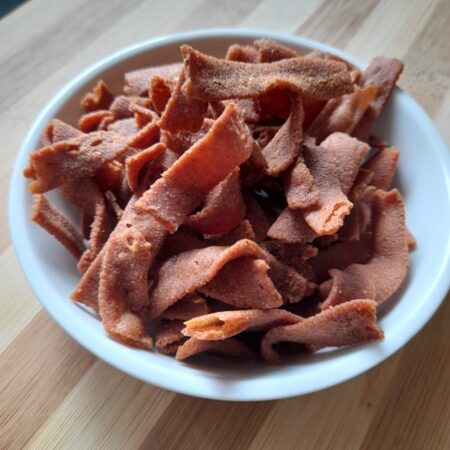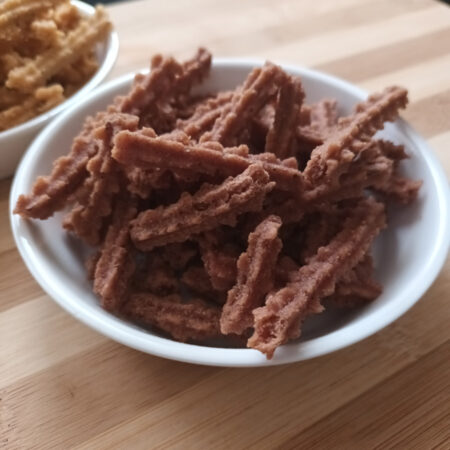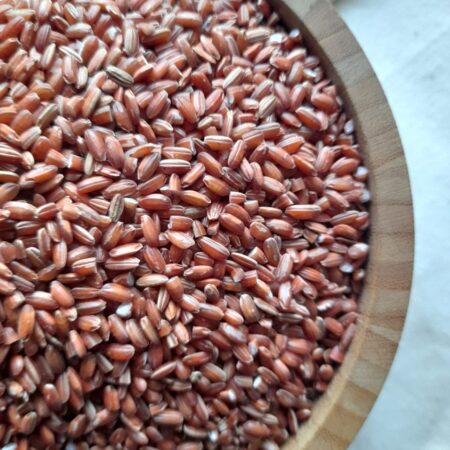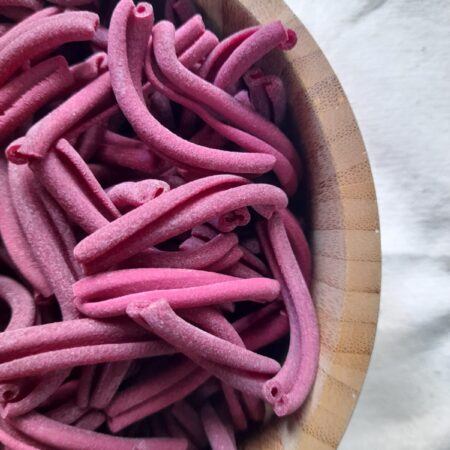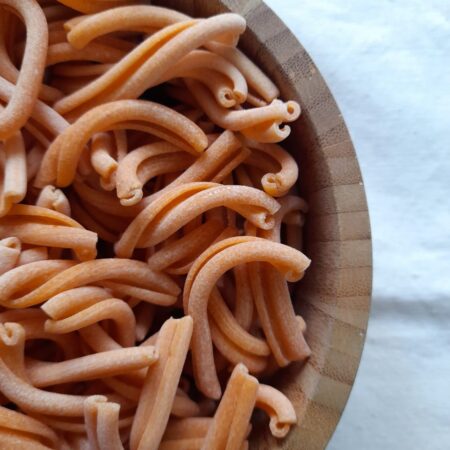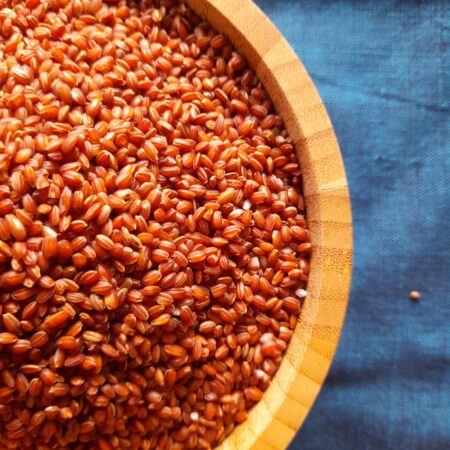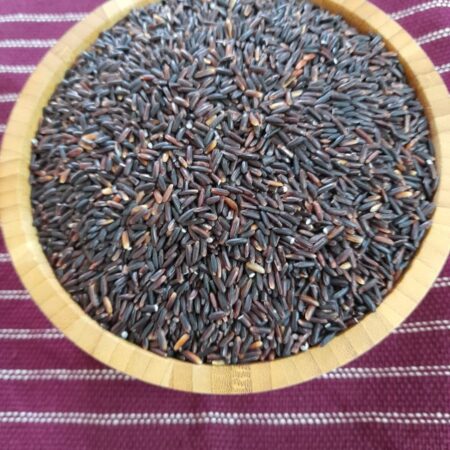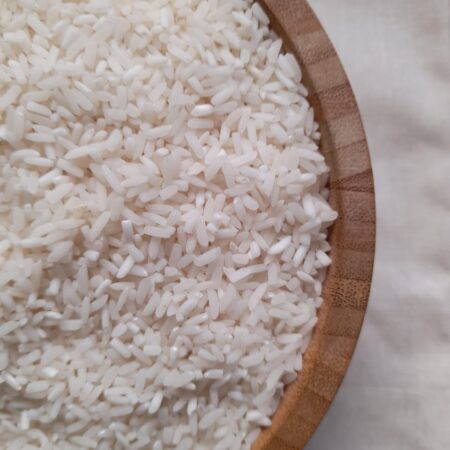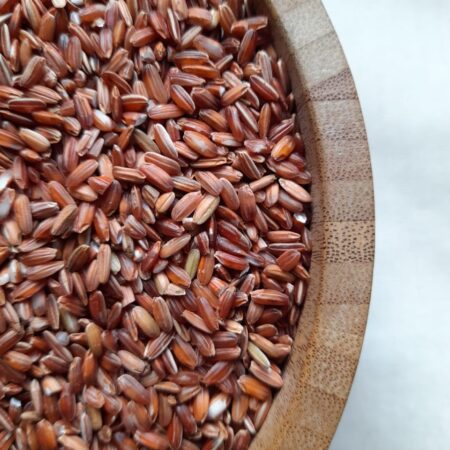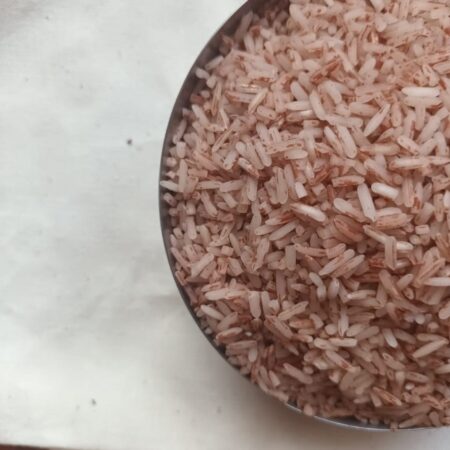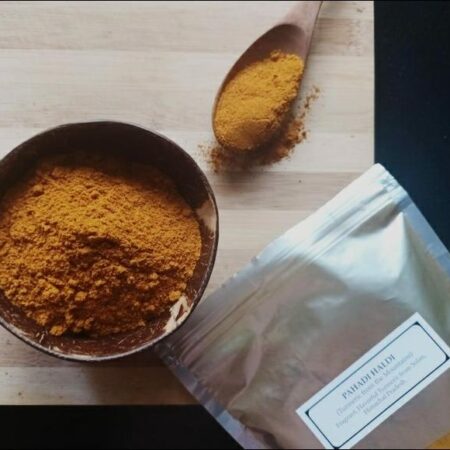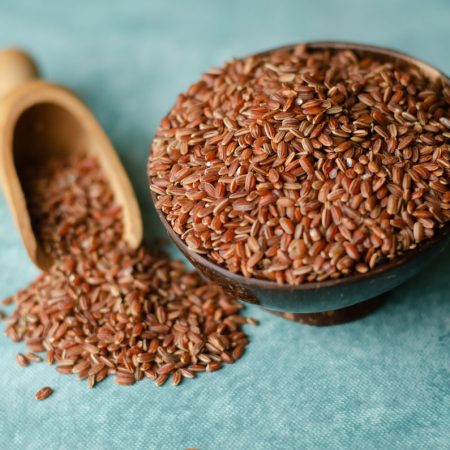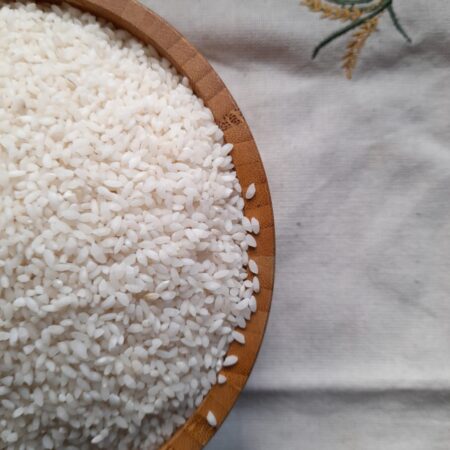At our 50-acre organic farm in Manjakkudi, Kumbakonam, we cultivate heritage, artisanal rice using purely organic practices. Rich in nutrients, heritage grains protect our soil; At our farm, located in the heart of the janma-bhoomi of Pujya Swami Dayananda Saraswati, we hand-select only the best quality seeds and harvest twice a year during the traditional harvesting season.
GRAINS OF GOODNESS
-
Acharmati
₹140.00 Per KgOdisha
Acharmati is a short bold rice from Odisha. Though it has pleasant yellow husk, when removed, the kernel is dull white in colour. This fragrant grain is an autumn crop and accordingly to farmers is a high yielding variety. Most scented rice variants from this region are used to make kichadi, pulao, kheer or served as plain table rice.
Cooking Instructions
Soak the Acharmati Raw polished rice for 1/2 hour before cooking. Cook it in the ratio of 1:2.5 (For 1 cup rice, add 2.5 cups water). Please adjust the water ratio according to your preference.
-
Acharmati Arisi Upma Mix
₹433.33 Per KgIngredients: Acharmati Rice, Chilli Flakes, Toor Dal, Pepper, Salt, Gram Dal, Urad Dal, Mustard, Jeera
Cooking Instructions: Heat sesame oil or coconut oil in a pan. Add mustard seeds and allow it to crackle. Add the split urad dal, curry leaves, hing, broken red chillies and onions (optional). Add 3 cups of water and let boil. Add 1 measure of Acharmati Upma blend, and let it cook in an open pan for 20 minutes. Once water is absorbed, remove from heat and close the pan. Let it rest for 10 minutes before serving.
-
Acharmati Rice Flour
₹160.00 Per KgOdisha
It can be used to make a variety of delicious recipes like Kozhukattai, Murukku, Idiyappam, Dosai, Akki Roti etc. It acts as a thickener in sauces, soups, stews, gravies, curries etc.
-
Adam Chini
₹140.00 Per KgUttar Pradesh
Cooking Instructions
Soak the Adam Chini Raw rice for 2-3 hours before cooking. Cook it in the ratio of 1:4 (For 1 cup rice, add 4 cups water). Please adjust the water ratio according to your preference.
Soak the Adam Chini Raw polished rice for 10 mts before cooking. Cook it in the ratio of 1:2.5 (For 1 cup rice, add 2.5 cups water). Please adjust the water ratio according to your preference.
-
Adanshilpa
₹140.00 Per KgWest Bengal
In 2018, the State Agricultural Marketing Department of West Bengal decided to set up rice and pulse mills. The main aim of these mills would be to help preserve the quality of the famous aromatic heritage rice varieties of Bengal like Adanshilpa. They tied up with Sufal Bangla to sell these heritage grains directly to the people and that too with the right cost. Initiatives like these benefit the farmer and the consumer.
Adanshilpa is a heritage rice variety, native to West Bengal, that is being retailed in these outlets. It is a long grained, scented red rice that is high in fibre, iron and anthocyanins
Cooking Instructions
Soak the Adanshilpa rice for 8 hours before cooking. Cook it in the ratio of 1:5 (For 1 cup rice, add 5 cups water). Please adjust the water ratio according to your preference.
-
Ajara Ghansal
₹140.00 Per KgMaharashtra
Ajara Ghansal grown in Kolhapur district is an aromatic grain, which has been cultivated over many generations in Ajara Taluk – some families of farmers have been cultivating Ghansal rice for more than 100 years. Known for its taste and aroma, Ghansal rice is tender and non-sticky.
Cooking Instructions
Soak the Ajara Ghansal raw rice for 2-3 hours before cooking. Cook it in the ratio of 1:4 (For 1 cup rice, add 4 cups water). Please adjust the water ratio according to your preference.
Soak the Ajara Ghansal Raw polished rice for 10 mts before cooking. Cook it in the ratio of 1:2.5 (For 1 cup rice, add 2.5 cups water). Please adjust the water ratio according to your preference.
-
Ambe Mohar
₹140.00 Per KgMaharashtra
“Pej/ Kanji (rice gruel) makes for a great health drink because it allows for better assimilation of Vit D & calcium,” explains nutritionist and fitness expert Rujuta Diwekar. And Ambemohar was the rice used by people in Maharashtra (particularly the Mulshi region in Pune) to prepare this nutritious dish, and it was relished by children and adults.
This short and low yielding grain has the aroma of mango blossoms, hence the name( Ambe means mango, mohar means flowers). It was extensively used in Maharashtra for religious ceremonies and during festivals; the rice was also used to make puffed rice called murmure; the bran from this grain has been used for oil extraction and mushroom cultivation. However since the yield was low, a hybrid variant called Indrayani with ambemohar parentage was developed by the Rice Research Centre near Lonavala. Due to this, farmers gave up this traditional grain in the late 1980s. Awarded a GI tag in 2016, Mulshi Ambemohar rice is believed to have been a favourite of the Peshwa rulers.
Cooking Instructions
Soak the Ambe Mohar raw rice for 2-3 hours before cooking. Cook it in the ratio of 1:4 (For 1 cup rice, add 4 cups water). Please adjust the water ratio according to your preference.
Soak the Ambe Mohar polished rice for 10 minutes before cooking. Cook it in the ratio of 1:2.5 (For 1 cup rice, add 2.5 cups water). Please adjust the water ratio according to your preference.
-
Arcot Kichili Champa Adai Batter
Per Kg₹180.00
Currently servicing Chennai city.
Available for store pick up every Tuesday & Friday.
Contact 87544 76702 to order.Ingredients: Arcot Kichili Champa Rice, Black Urad Dal, Tuvar Dal, Chana Dal, Moringa Leaves, Jeera Seeds, Ginger, Red Chilli, Asafoetida, Turmeric, Salt and RO Water.
-
Anandanoor Sanna
₹130.00 Per KgTamilnadu
This traditional variety is named after the region it was cultivated, namely Anandanoor. After interactions with local farmers, we believe this could be around modern day Salem district. Sanna indicates the fine, delicate feature of this grain as Sanna refers to fine and thin in Tamil. This is a slender white grain and cooks very well making Anandanoor Sanna a preferred choice for tamarind rice, sambar rice and every day rice preparations. Ananda also means joy, which holds true in the case of this rice because of its light texture and easy to digest properties!
Cooking Instructions
ags: Brown Rice, Everyday Table Rice, Iddly, Dosa, CholestrolSoak the Anandanoor Sanna Raw polished rice for 10 mts before cooking. Cook it in the ratio of 1:2.5 (For 1 cup rice, add 2.5 cups water). Please adjust the water ratio according to your preference.
-
Arubatham Kuruvai
₹130.00 Per KgTamilnadu
Arubatham Kuruvai is a short duration crop, taking only 60 days to harvest. This red rice is high in protein and calcium content; it strengthens your bones, boosts your immune system, and helps with weight loss efforts. Considered a ‘mota rice’ (bold grain), it prevents the onset of diabetes and also optimizes the digestive process.
Cooking Instructions
Soak the Arubatham Kuruvai Raw Rice for 8 hours before cooking. Cook it in the ratio of 1:5 (For 1 cup rice, add 5 cups water). Please adjust the water ratio according to your preference.
-
Bakul Phool
₹140.00 Per KgWest Bengal
Bakul Phool is one of those heritage rice varieties with a heavy panicle – so when the rice is milled, you would notice that it is large in size. Many have even mistaken it for wheat! But, it is heritage rice, and our sources at the farm have explained that since the grain emits a gracious, yet deep and rich fragrance, similar to the bakul flowers, it was given that name. Some others have told us that the rice flowers resemble the bakul flowers, hence the name.
In his book, ‘ Seeds of Tradition, Seeds of Future’ Dr.Debal Deb writes that the yield potential of Bakul phool was realized when a farmer-volunteer grew it in his farm in Bankura with appropriate supply of organic nutrients and crop spacing. Many heritage rice varieties have greater mean panicle density and grain weight than most high yielding varieties –in short this means that even when grown with zero agrochemical inputs rice varieties, like Bakul Phool can often out-perform most HYVs in terms of grain output.
Cooking Instructions
Soak the rice for 2-3 hours before cooking. Cook it in the ratio of 1:4 (For 1 cup rice, add 4 cups water). Please adjust the water ratio according to your preference.
Soak the Bakul Phool Raw polished rice for 10 mts before cooking. Cook it in the ratio of 1:2.5 (For 1 cup rice, add 2.5 cups water). Please adjust the water ratio according to your preference.
-
Bakul Phool Brown Rice Flakes Muesli
₹1,416.67 Per KgIngredients: Bakul Phool Brown Rice Flakes, Ragi Flakes, Pumpkin & Flax Seeds, Almonds & Walnuts, Brown & Black Raisins, Freeze Dried Mango, sweetened with Honey and Jaggery
-
Katarni Brown Rice Flakes Muesli
₹1,416.67 Per KgIngredients: Katarni Brown Rice Flakes, Ragi Flakes, Sabja Seeds, Melon Seeds, Almonds & Walnuts, Brown & Black Raisins, Freeze Dried Apricot, sweetened with Honey and Jaggery
-
-
Banshpata
₹140.00 Per KgWest Bengal
Farmers select rice varieties for cultivation at the start of each season; each grain has one or more distinctive properties – size, shape, color, cooking quality, fragrance, taste and traditional use. West Bengal has many aromatic heritage rice variants, one of them being Banshpata. It is popular with farmers in the Medinipore and Nadia districts of West Bengal. This long grain has diversified end-uses like : everyday table rice, special dayrice (biriyani, pulao), dessert (payesh) or even for fragrant sweets (JaynagarerMoa).
Cooking Instructions
Soak the Banshpata Raw polished rice for 10 mts before cooking. Cook it in the ratio of 1:2.5 (For 1 cup rice, add 2.5 cups water). Please adjust the water ratio according to your preference.
-
Biliya
₹140.00 Per KgKarnataka
Cooking Instructions
ags: Brown Rice, Everyday Table Rice, Iddly, Dosa, CholestrolSoak the Biliya Raw Polished rice for for 10 mts before cooking. Cook it in the ratio of 1:2.5 (For 1 cup rice, add 2.5 cups water). Please adjust the water ratio according to your preference.
-
Bommi
₹130.00 Per KgTamilnadu
Cooking Instructions
Soak the Bommi Raw polished rice for 10 mts before cooking. Cook it in the ratio of 1:2.5 (For 1 cup rice, add 2.5 cups water). Please adjust the water ratio according to your preference.
Soak the Bommi boiled polished rice for 10 mts before cooking. Cook it in the ratio of 1:3 (For 1 cup rice, add 3 cups water). Please adjust the water ratio according to your preference.
-
Bora
₹140.00 Per KgAssam
In Assam it is common to serve the glutinous Bora rice at social and religious gatherings. The rice is paired with milk or curd along with a liberal spoon of sugar or jaggery. However, people in Assam use the Bora rice extensively to make ‘everyday specials’ like rice beer, pithas (biscuit like confectionaries), chira (flaked rice), sunga chaol (roasted rice inside bamboo internode), hurum (expanded waxy rice), and sandoh guri (roasted parboiled rice powder) all through the year.
Sivasagar a town located in Assam was once the seat of the Ahom kings and is, thus, historically important. The palace in this town referred to as the Kareng Ghar was initiated in 1698 CE. It was originally built on brick and bamboo, and during the reign of Rajehswar Singha, ‘unusual’ binding ingredients, such as a paste made from bora rice and duck eggs were used, to hold different components together. Today, though the palace is in dilapidated condition, the structure is still intact!
Cooking Instructions
Soak the Bora raw rice for 2 hours before cooking. Cook it in the ratio of 1:4 (For 1 cup rice, add 4 cups water). Please adjust the water ratio according to your preference.
-
Chak Hao Amubi
₹250.00 Per KgManipur
In a paper titled ‘The Deep Purple Colour and the Scent are the Two Great Qualities of the Black Scented Rice of Manipur’ authors Ibemhal Devi Asem, Rajkumar Imotomba and Pranab B Mazumdar state that one serving of black rice even though it contains some calories, offers a high amount of flavanoid phytonutrients, important fibre, mineral content such as iron, copper and is a good source of plant-based protein. This is why the West now classifies the black rice, as a super food.
Some of the purple coloured Chak Hao rice varieties include Poireiton, Amubi, Wairi,Khurlkul Chak Hao, Pong Chak Hao and more. The deep colour and sweet fragrance are what make these, specialty rices.
In Manipur, these varieties were reserved for community feasts and ceremonial purposes. In some parts, a special snack called ‘Uton Chak’(rice cooked in bamboo tubes) is still served using the Chak Hao grain. The royal chronicles mention that from very early times onwards, Kings, Queens, and noblemen used to go out to eat Utong-chak. Bamboo tubes, about 60 cms long, cut from a very small variety of bamboo, were stuffed with washed rice and covered on both ends. The bamboo tube was then grilled on fire; the charred outer layer is first removed and the rice is enjoyed, with a bit of the bamboo pulp.
Today, across the globe these varieties are being used to make desserts, breads and beverages.
Cooking Instructions
Soak the Chak Hao Amubi rice for 8 hours before cooking. Cook it in the ratio of 1:5 (For 1 cup rice, add 5 cups water). Please adjust the water ratio according to your preference.
-
Chak Hao Poireiton
₹250.00 Per KgManipur
Chak Hao Poireiton is a black rice from Manipur. The literal meaning of Chak Hao is ‘delicious rice’ (Chak – rice; Hao-delicious). This sticky textured rice is rich in fibre and it usually turns deep purple when cooked due to its anthocuanin content. This grain has disease fighting antioxidants and prevents diabetes, cancer and heart disease. One serving of black rice offers a high amount of flavanoid phytonutrients, mineral content such as iron and copper and. It is a good source of plant-based protein.
Cooking Instructions
Soak the Chakhao Poireiton raw rice for 8 hours before cooking. Cook it in the ratio of 1:5 (For 1 cup rice, add 5 cups water). Please adjust the water ratio according to your preference.
-
Chennel
₹140.00 Per KgKerala
Cooking Instructions
ags: Brown Rice, Everyday Table Rice, Iddly, Dosa, CholestrolSoak the Chennel Raw rice for 8 hours before cooking. Cook it in the ratio of 1:5 (For 1 cup rice, add 5 cups water). Please adjust the water ratio according to your preference.
-
Chennel Poha
₹170.00 Per Kg -
Dadshal
₹140.00 Per KgWest Bengal
Dadshal is classified as a scented rice variety – however, it does not have a strong fragrance like its counterpart, the Gobinda Bhog. But, if you want ‘tasty’ table rice, this is it. Chef Anumitra Ghosh Dastidar, owner of Edible Archives restaurant in Anjuna, Goa, explains that it is possible to replace imported ingredients with local produce to make an international dish. “One can try using India’s indigenous rice varieties to make say, sushi or risotto,” she said reflecting on her own experience of using the ‘Dadshal’ rice variety of West Bengal.
After cyclone Aila hit Sundarbans in 2009, the modern salt-tolerant seeds couldn’t survive increased salinity of soil. It compelled Sudebi Mandal from Uttar Gobindokathi village of Sundarbans in North 24 Parganas district to explore heritage rice varieties. In an interview to Down to Earth, she explains that farmers now cultivate Kantarangi and Nico—FRVs (folk rice varieties) that can thrive under such conditions. They are also experimenting with aromatic strains like Kanakchur, Gobindo Bhog, Kamini Bhog, Dadshal and Chinakamini—for the past three years.
Cooking Instructions
Soak the Dadshal Raw rice for 2-3 hours before cooking. Cook it in the ratio of 1:4 (For 1 cup rice, add 4 cups water). Please adjust the water ratio according to your preference.
Cooking Instructions: Soak the Dadshal Raw polished rice for 10 mts before cooking. Cook it in the ratio of 1:2.5 (For 1 cup rice, add 2.5 cups water). Please adjust the water ratio according to your preference.
-
Dayala Modina
₹140.00 Per KgWest Bengal
Cooking Instructions
Soak the Dayala Modina boiled polished rice for 10 mts before cooking. Cook it in the ratio of 1:3 (For 1 cup rice, add 3 cups water). Please adjust the water ratio according to your preference.
-
Dudeshwar
₹140.00 Per KgWest Bengal
In India, rice is revered as a symbol of auspiciousness and prosperity and hence, is used extensively in all ceremonies and festivals. Dr Debal Deb, Founder of Vrihi and Basudha, says, “The standard expression in Bengal, “Have you eaten rice?” is a polite way to inquire, “Have you had your lunch or dinner?” Explaining the strong connect with rice he adds, “All rites of passage in Bengali culture – from birth to death – are marked with raw rice, milled rice and cooked rice. Every traditional ceremonial feast has servings of aromatic rice delicacies such as polao (sweet pilaf) and payes (rice pudding).” We believe another favorite amongst Bengali’s after Gobindo Bhog and Radha Tilak, is Dudeshwar.
This flavorful grain is cultivated in the Sundarbans as well as other regions in Bengal and gets its name from the color of the grain, resembling pure white milk. A short, fine, non aromatic grain, Dudeshwar becomes soft and tender on cooking and lends its strong flavor to any dish it is added to. We recommend using this in your payesh or phirni!
Cooking Instructions
Soak the Dudeshwar Raw Rice for 2-3 hours before cooking. Cook it in the ratio of 1:4 (For 1 cup rice, add 4 cups water). Please adjust the water ratio according to your preference.
Soak the Dudeshwar Raw polished rice for 10 mts before cooking. Cook it in the ratio of 1:2.5 (For 1 cup rice, add 2.5 cups water). Please adjust the water ratio according to your preference.
-
Gandhakasala
₹140.00 Per KgKerala
The origins of this fragrant rice can be traced back to Wayanad district in Kerala. It was mostly grown by the tribal communities and is believed to be a competitor to the well known fragrant rice varieties like Basamati and Jasmine rice. With high disease resistant properties, nutritional value and great taste, Ghandhakasala was used for all family celebrations. It received the Geographical Indication (GI) status in 2010.
Cooking Instructions
Soak the Gandhakasala Raw rice for 2-3 hours before cooking. Cook it in the ratio of 1:4 (For 1 cup rice, add 4 cups water). Please adjust the water ratio according to your preference.
Soak the Gandhakasala Raw polished rice for 10 mts before cooking. Cook it in the ratio of 1:2.5 (For 1 cup rice, add 2.5 cups water). Please adjust the water ratio according to your preference.
-
Gandhakasala Brown Rice Murukku
₹925.00 Per KgIngredients: Brown Rice Flour, Fried Gram Flour, Salt, Vegetable Oil, Cumin Seeds, Sesame & Asafoetida
-
-
Garudan Champa
₹130.00 Per KgTamilnadu
Also known as ‘Kaadai Kazhuththaan’ in some parts of Tamil Nadu, the Garudan Champa grain has the a white streak, very similar to the one found on the neck of the Brahmini kite (Garudan), hence it was given the name. Garudan Champa was investigated for its phytochemical screening; the results revealed that this grain has high levels of important phytoconstituents and has the capacity to prevent many health related disorders. A long and fine grain, farmers have told us that it improves blood circulation and blood purification.
Cooking Instructions
Soak the Garudan Champa Raw rice for 2-3 hours before cooking. Cook it in the ratio of 1:4 (For 1 cup rice, add 4 cups water). Please adjust the water ratio according to your preference.
-
Gobinda Bhog
₹140.00 Per KgWest Bengal
This traditional aromatic rice variety has a history of over 300 years; The Geographical Indications Registry (GIR) has granted Geographical Indication (GI) status to Gobinda Bhog, a speciality from Burdaman district of West Bengal. It is a short grain rice, with a buttery flavor which works well as a table rice. It is categorised as a ‘Khaas Dhan’ or ‘Special Grain’, because it is offered as prasad to Lord Krishna during the Janmashtami celebrations.
Cooking Instructions
Soak the Gobinda Bhog raw rice for 2-3 hours before cooking. Cook it in the ratio of 1:4 (For 1 cup rice, add 4 cups water). Please adjust the water ratio according to your preference.
Soak the Gobinda Bhog Raw polished rice for 10 minutes before cooking. Cook it in the ratio of 1:2.5 (For 1 cup rice, add 2.5 cups water). Please adjust the water ratio according to your preference.
-
Gopal Bhog
₹140.00 Per KgWest Bengal
Cooking Instructions
Soak the Gopal Bhog Raw polished rice for 10 mts before cooking. Cook it in the ratio of 1:2.5 (For 1 cup rice, add 2.5 cups water). Please adjust the water ratio according to your preference.
-
Illupai Poo Champa
₹130.00 Per KgTamilnadu
Illupai Poo is amongst the rare, scented varieties of rice cultivated in Tamil Nadu. This grain gets its name because the paddy resembles flowers of the Illupai tree. And emanates a fragrance similar to the Illupai ‘Poo’ (flower) of the Bassia Latifolia or Mahua flower.
Illupai Poo Champa has been mentioned in Pathartha Gunapadam by Siddhar Theraiyar, on medicinal food and herbs. Locals believe this variety has the strength to improve hemoglobin levels and boost immunity.
The grains are long and slender and have a greenish hue. This is a medium duration crop that takes 130 – 145 days. Illupai Poo Champa is a local favorite for its distinct aroma and flavor and is used in making porridge/kanji and festive preparations like payasam. This grain makes for light and flavorful rice flakes or poha, a breakfast staple in most parts of India.Cooking Instructions
Soak the Illupaipoo raw rice for 2-3 hours before cooking. Cook it in the ratio of 1:4 (For 1 cup rice, add 4 cups water). Please adjust the water ratio according to your preference.
Soak the Illupai Poo Champa Raw polished rice for 10 minutes before cooking. Cook it in the ratio of 1:2.5 (For 1 cup rice, add 2.5 cups water). Please adjust the water ratio according to your preference.
-
Illupai Poo Champa Poha
₹170.00 Per KgTamilnadu
Illupai Poo is amongst the rare, scented varieties of rice cultivated in Tamil Nadu. This grain gets its name because the paddy resembles flowers of the Illupai tree. And emanates a fragrance similar to the Illupai ‘Poo’ (flower) of the Bassia Latifolia or Mahua flower.
Illupai Poo Champa has been mentioned in Pathartha Gunapadam by Siddhar Theraiyar, on medicinal food and herbs. Locals believe this variety has the strength to improve hemoglobin levels and boost immunity.
The grains are long and slender and have a greenish hue. This is a medium duration crop that takes 130 – 145 days. Illupai Poo Champa is a local favorite for its distinct aroma and flavor and is used in making porridge/kanji and festive preparations like payasam. This grain makes for light and flavorful rice flakes or poha, a breakfast staple in most parts of India.Cooking Instructions
Soak the Iluppai Poo Champa Poha for 5 minutes before cooking.
-
Jawa Phool
₹140.00 Per KgChhattisgarh
Jawa Phool rice, is also known as Ambamor, Tulsi Mala and Vishnu Bhog rice and is from the rich soil of Chhattisgarh. This is a traditional non – Basmati rice which takes approximately 125 days to cultivate and is small to medium in size. It is believed, Jawaful or Jawa Phool is one of the oldest rice cultivated in the region of Chhattisgarh and Madhya Pradesh. This variety has a wonderful aroma and taste and was reserved for special occasions and festivals; however, we paired this with dal, made pulao and served with just a dollop of ghee and it tastes just as good. Jawa Phool is a rich source of protein and fiber and is known to contain a good amount of essential nutrients such as selenium and zinc.
Today, this rare rice has travelled from kitchens in Chhattisgarh, and is being cultivated in Manjakkudi, Tamil Nadu.Cooking Instructions
Soak the Jawa Phool raw rice for 2-3 hours before cooking. Cook it in the ratio of 1:4 (For 1 cup rice, add 4 cups water). Please adjust the water ratio according to your preference.
-
Jeera Battis
₹140.00 Per KgUttar Pradesh
Benaras, the land of ghats, temples, sadhus and silk, is where every stone has a special story to tell In April 2023, the Economic Times stated, “In Uttar Pradesh, a total of 45 products are slated to possess the coveted GI tag, out of which 22 are from the Varanasi region alone”. Jeera Battis, is one such prized grain from Varanasi.
Jeera Battis is the preferred everyday rice for its mild aroma, soft and delicate flavors. This small grain is easy to cook making it a preferred variety for seasonal curries, tehri, daal and pulav. Some locals prefer the mild subtle aroma of Jeera Battis over Basmati calling it the ‘Queen of Rice”.
Earlier, Jeera Battis was grown all across Benaras and Chandauli district, popularly known as the Dhaan Ka Katora of Uttar Pradesh for their cultivation of non-Basmati grains, but disappeared with time and rapid increase of cultivation of high yielding varieties. Today, this lost grain from Benaras is revived and conserved at our farm in Manjakkudi, Tamil Nadu
Cooking Instructions
Soak the Jeera Battis Raw polished rice for 10 mts before cooking. Cook it in the ratio of 1:2.5 (For 1 cup rice, add 2.5 cups water). Please adjust the water ratio according to your preference.
-
Jeera Phool
₹140.00 Per KgChhattisgarh
This aromatic grain resembles a long and fine cumin seed – that could possibly be the reason it was given the name jeera (cumin) phool (flower). About a decade ago, this rice was found and available within its place of origin. However, in 2005, a group of 20 tribal women farmers from six villages in Surguja district in Chhattisgarh, realized the threats to the survival of this heritage rice. They formed a self-help group to protect and promote it. Within a few years, more people joined their pursuit and they eventually registered this variety with Plant Varieties and Farmers’ Rights Authority of India. The group then applied for a Geographical Indication (GI) tag, which was approved on in March 2019.
The grain when cooked al dente works well as a pilaf, and when cooked till soft, it pairs well with your lentil-based gravies.
Cooking Instructions
Soak the Jeeraphool Raw polished rice for 10 mts before cooking. Cook it in the ratio of 1:2.5 (For 1 cup rice, add 2.5 cups water). Please adjust the water ratio according to your preference.
-
Jeeraga Champa
₹130.00 Per KgTamilnadu
Jeeraga Champa is an aromatic rice that resemble the seeds of jeera (seeragam / cumin). Cultivated during the champa season (August to January), this grain is rich in fibre and vitamins. It is believed to prevent colon and intestine cancer and reduce cholesterol. Traditionally, it is used in the preparation of biryani, and Tamil Nadu favourites like the tomato rice, lemon rice and tamarind rice.
Cooking Instructions
Soak the Jeeraga Champa Raw rice for 2-3 hours before cooking. Cook it in the ratio of 1:4 (For 1 cup rice, add 4 cups water). Please adjust the water ratio according to your preference.
Soak the Jeeraga Champa Raw polished rice for 10 mts before cooking. Cook it in the ratio of 1:2.5 (For 1 cup rice, add 2.5 cups water). Please adjust the water ratio according to your preference.
-
Jeerakasala
₹140.00 Per KgKerala
Jeerakasala rice, also known as Wayanadan Kaima, is a popular aromatic rice; it is a with a lovely fragrance that permeates throughout the dining room when served. Because of its high disease resistant properties, nutritional value and fine taste, this variety of rice is traditionally used in wedding feasts. They use this rice to make the famous Thalassery Biryani. Some farmers have stated that it has the lowest carbohydrate content making it most suitable for persons with diabetes or those advised to follow a low-sugar diet. Like Gandhakasala, Jeerakasala received the Geographical Indication (GI) status in 2010.
Cooking Instructions
Soak the Jeerakasala Raw rice for 2-3 hours before cooking. Cook it in the ratio of 1:4 (For 1 cup rice, add 4 cups water). Please adjust the water ratio according to your preference.
Soak the Jeerakasala Raw polished rice for 10 mts before cooking. Cook it in the ratio of 1:2.5 (For 1 cup rice, add 2.5 cups water). Please adjust the water ratio according to your preference.
-
Kaatuyaanam
₹130.00 Per KgTamilnadu
Kaatuyaanam a rice variety cultivated mainly in Tamil Nadu grows over seven feet tall. It has the ability to hide an elephant, hence the crop was given this name. (‘Kaatu’ meaning forest and ‘Yaanam’ meaning elephant). The rice keeps diabetics and arthritis under control, boosts immunity and protects against skin problems. Very high in folic acid, it helps strengthen the pelvic bone so it was regularly given to pregnant women.
Cooking Instructions
ags: Brown Rice, Everyday Table Rice, Iddly, Dosa, CholestrolSoak the Kaatuyaanam Raw rice for 8 hours before cooking. Cook it in the ratio of 1:5 (For 1 cup rice, add 5 cups water). Please adjust the water ratio according to your preference.
-
-
-
Kaatuyaanam Red Rice Murukku
₹925.00 Per KgIngredients: Red Rice Flour, Fried Gram Flour, Salt, Vegetable Oil, Cumin Seeds, Sesame & Asafoetida
-
Kabiraj Sal
₹140.00 Per KgWest Bengal
A medium fine rice, the Kabiraj Sal is a medicinal rice, known for its therapeutic use. Rich in iron, zinc & vitamin B, this rice was traditionally given to patients recovering from prolonged illness, as a nourishing food which is easy to digest. “Traditional rice varieties are inherently endowed with at least 30 percent to 70 percent higher nutritional value than their chemically grown counterparts, “ explains Sudeb Saha, a medical practitioner from Raiganj in Uttar Dinajpur and vice-president of Forum for Indigenous Agricultural Movement, in an interview to the online publication Your Story. Like Spirit of the Earth, FIAM is made up of school teachers, professors and doctors mostly in their 30s and 40s trying to revive heritage rice that we have lost.
Cooking Instructions
Soak the Kabirajsal Raw polished rice for 10 mts before cooking. Cook it in the ratio of 1:2.5 (For 1 cup rice, add 2.5 cups water). Please adjust the water ratio according to your preference.
-
Kala Bhat
₹180.00 Per KgWest Bengal
We often associate black rice to desserts; But did you know, that the Kala Bhat, a mildly fragrant black rice from West Bengal was initially used to prepare pulaos? Due to its fine taste and limited yield, it was reserved for special occasions. Black rice turns a shade purple when cooked and is filled with high amounts of anthocyanins. Anthocyanins are phytochemicals found in deep blue and purple food (like berries and aubergines) which are thought to fight chronic diseases such as cancer and heart disease. Regular consumption of this rice can help in detoxifying the body, prevent diabetes, protect heart health and lower cholesterol.
Like other whole-grain rice varieties, black rice has a low glycemic index, meaning that sugar is absorbed more slowly, providing a more stable energy source and avoiding the spikes in blood sugar associated with other carbohydrate-rich foods.
10 spoonfuls of cooked black rice, contains the same amount of anthocyanin as a spoonful of fresh blueberries, according to a study presented at the American Chemical Society, in Boston. So, today, it has been categorized as a ‘super food’.
Cooking Instructions
Soak the Kala Bhat raw rice for 8 hours before cooking. Cook it in the ratio of 1:5 (For 1 cup rice, add 5 cups water). Please adjust the water ratio according to your preference.
-
Kala Namak
₹140.00 Per KgUttar Pradesh
When Gautam Budhha visited Kapilvastu for first time after attaining enlightenment, he gave the grains of Kala Namak to the local people and asked them to sow it. This grain is often called ‘Buddha’s Gift’ and was also found in a kitchen store of a house in UP in one of the excavations. With the husk being black and the ability to grow in saline soils, this grain was appropriately called Kala (black) and Namak (salt). This fragrant grain was granted Geographical Indication (GI) tag in 2012. It is considered one of the finest rice varieties in the international market, people suffering from kidney problems and those with skin and blood-related ailments are advised to consume this variety of rice.
Cooking Instructions
Soak the Kala Namak Raw rice for 2-3 hours before cooking. Cook it in the ratio of 1:4 (For 1 cup rice, add 4 cups water). Please adjust the water ratio according to your preference.
Soak the Kala Namak Raw polished rice for 10 minutes before cooking. Cook it in the ratio of 1:2.5 (For 1 cup rice, add 2.5 cups water). Please adjust the water ratio according to your preference.
-
Kalajeera
₹140.00 Per KgOdisha
Kalajeera, also known as the ‘Prince of Rice’ is an aromatic variety. Originating from Orissa, this lowland scented rice variety looks like coriander seeds. It is believed to increase hemoglobin levels and the body metabolism. This fragrant grain has antispasmodic, stomachic, carminative, antibacterial, astringent and sedative properties. Ancient text explains that Kalajeera improves memory and controls diabetes.
Cooking Instructions
Soak the Kalajeera Raw Rice for 2-3 hours before cooking. Cook it in the ratio of 1:4 (For 1 cup rice, add 4 cups water). Please adjust the water ratio according to your preference.
Soak the Kalajeera Raw polished rice for 10 mts before cooking. Cook it in the ratio of 1:2.5 (For 1 cup rice, add 2.5 cups water). Please adjust the water ratio according to your preference.
Soak the Kalajeera Boiled polished rice for 10 mts before cooking. Cook it in the ratio of 1:3 (For 1 cup rice, add 3 cups water). Please adjust the water ratio according to your preference.
-
Kamini Bhog
₹140.00 Per KgWest Bengal
Kamini Bhog was and still is reserved for those special occasions in many parts of India. Though not as popular as Gobinda Bhog, this glutinous rice originating in from the Sundarbans grows in deep water. This bold scented rice, is often parboiled or made into rice flakes (chira) and are used extensively in rituals.
On February 10, 1904, Viceroy Lord Curzon visited Burdwan to confer the title of maharaja on then king of Burdwan Vijaychanda, says Niradabaran Sarkar, a historian of Burdwan. Vairabchandra Nag, a local sweet-maker, had made the sitabhog and mihidana to mark the occasion. Lord Curzon was surprised to have such unique sweets and praised and thanked Vairabchandra Nag in the certificate given to him saying he never had such sweet ever before.
Mihidana is today one of the most sought after sweets from Bengal. It is made from powdered Kamini Bhog, Gobinda Bhog and basmati rice, mixed with a small amount of besan and saffron for a golden colour. They are blended very well with water by hand till it turns light and the mix is poured through a brass ladle with tiny holes into a pot of ghee and deep-fried. The fine fried small rice-like grains are dipped in sugar syrup and drained once soaked.
Cooking Instructions
Soak the Kamini Bhog Raw rice for 2-3 hours before cooking. Cook it in the ratio of 1:4 (For 1 cup rice, add 4 cups water). Please adjust the water ratio according to your preference.
Soak the Kamini Bhog Raw polished rice for 10 minutes before cooking. Cook it in the ratio of 1:2.5 (For 1 cup rice, add 2.5 cups water). Please adjust the water ratio according to your preference.
-
-
Kamini Bhog Rice Flour
₹160.00 Per KgWest Bengal
It can be used to make a variety of delicious recipes like Kozhukattai, Murukku, Idiyappam, Dosai, Akki Roti etc. It acts as a thickener in sauces, soups, stews, gravies, curries etc.
-
Kanali
₹140.00 Per KgKerala
Cooking Instructions
Soak the Kanali Raw rice for 8 hours before cooking. Cook it in the ratio of 1:5 (For 1 cup rice, add 5 cups water). Please adjust the water ratio according to your preference.
-
Kari Basmati
₹140.00 Per KgKarnataka
Cooking Instructions
Soak the Kari Basmati Raw Rice for 2-3 hours before cooking. Cook it in the ratio of 1:4 (For 1 cup rice, add 4 cups water). Please adjust the water ratio according to your preference.
Soak the Kari Basmati Raw polished rice for 10 mts before cooking. Cook it in the ratio of 1:2.5 (For 1 cup rice, add 2.5 cups water). Please adjust the water ratio according to your preference.
-
Karunjeeraka Champa
₹130.00 Per KgTamil Nadu
Cooking Instructions
Soak the Karunjeeraka Champa Raw Rice for 2-3 hours before cooking. Cook it in the ratio of 1:4 (For 1 cup rice, add 4 cups water). Please adjust the water ratio according to your preference.
-
Karunkuruvai
₹130.00 Per KgTamilnadu
The Karunkuruvai is an important sub species of kuruvai (summer crop) rice variety. Dark brown to black in colour, this rice helps treat elephantiasis, arthritis, and chickenpox. The Karunkuruvai grain is believed to have ‘Kayakalpam’ properties as it helps protect the body and keep it healthy. Siddha doctors use this rice variety to treat certain conditions, including repairing cell damage. This nutritious grain is believed to control diabetes, cholesterol, blood pressure, and purify blood.
Cooking Instructions
Soak the Karunkuruvai raw rice for 8 hours before cooking. Cook it in the ratio of 1:5 (For 1 cup rice, add 5 cups water). Please adjust the water ratio according to your preference.
-
Karuppu Kavuni
₹180.00 Per KgTamilnadu
This black rice called as ‘Kavuni Arisi’ in Tamil, is a rich grain which has been grown in India since the Chola Period. With powerful disease-fighting antioxidants, this sticky rice, contains dietary fiber, anti-inflammatory properties, and has the ability to prevent diabetes, cancer, heart disease and even weight gain.
Cooking Instructions
Soak the Karuppu Kavuni Raw rice for 8 hours before cooking. Cook it in the ratio of 1:5 (For 1 cup rice, add 5 cups water). Please adjust the water ratio according to your preference.
-
Katarni
₹140.00 Per KgBihar
Katarni is an aromatic grain and was reserved for ‘ceremonial’ events. Native to Bhagalpur and Banka districts of Bihar, this rice has been facing the threat of extinction. Legend has it that the local regent Maharaja Rahmat Ali Khan Bahadur of Kharagpur pioneered Katarni plantation in the region. From this virgin batch of seeds, virtually all of today’s-observed crops are proliferated.
The word ‘Katami’ literally means an ‘awl with a hook at the end for sewing’. Awl is a pointed tool for making holes in wood or leather. The name Katami has been derived due to the shape of the apex of paddy which is similar to the tip of awl.
Katarni rice has been registered with the Geographical Indications (GI) registry of Government of India in 2018.
Cooking Instructions
Soak the Katarni raw rice for 2-3 hours before cooking. Cook it in the ratio of 1:4 (For 1 cup rice, add 4 cups water). Please adjust the water ratio according to your preference.
Soak the Katarni Raw polished rice for 10 mts before cooking. Cook it in the ratio of 1:2.5 (For 1 cup rice, add 2.5 cups water). Please adjust the water ratio according to your preference.
-
Katarni Poha
₹170.00 Per KgBihar
Katarni is an aromatic grain and was reserved for ‘ceremonial’ events. Native to Bhagalpur and Banka districts of Bihar, this rice has been facing the threat of extinction. Legend has it that the local regent Maharaja Rahmat Ali Khan Bahadur of Kharagpur pioneered Katarni plantation in the region. From this virgin batch of seeds, virtually all of today’s-observed crops are proliferated.
The word ‘Katami’ literally means an ‘awl with a hook at the end for sewing’. Awl is a pointed tool for making holes in wood or leather. The name Katami has been derived due to the shape of the apex of paddy which is similar to the tip of awl.
Katarni rice has been registered with the Geographical Indications (GI) registry of Government of India in 2018.
Cooking Instructions
Soak the Katarni Poha for 5 minutes before cooking.
Tags: Poha -
Kerala Sundari
₹140.00 Per KgWest Bengal
Popular in the Sunderbans, Kerala Sundari is a non-scented, bold rice and a good yielder. People are still unsure of why it is called Kerala Sundari; could it have migrated from Kerala? We have no documented evidence to prove this migration. But, what we do know is that this slender shaped grain is being revived by over 1000 farmers in and around Puralia district and is high in demand! If you are looking for everyday table rice, this is the one!
Cooking Instructions
Soak the Kerala Sundari Raw rice for 2-3 hours before cooking. Cook it in the ratio of 1:4 (For 1 cup rice, add 4 cups water). Please adjust the water ratio according to your preference.
Soak the Kerala Sundari raw polished rice for 1/2 hour before cooking. Cook it in the ratio of 1:2.5 (For 1 cup rice, add 2.5 cups water). Please adjust the water ratio according to your preference.
-
Ketaki Joha
₹140.00 Per KgAssam
Heritage rice varieties from Assam, that are medium and short grain, and scented are broadly classified as ‘Joha’. There are many varieties of joha, and one of them is Ketaki Joha. A Sali crop (winter crop) all the joha varieties are fine grains and have a pleasant aroma, and they do fetch a premium price in the market, as they are low yielders. In Assam, farmers still cultivate it for their home consumption, and use it at special occasions.
Some associate the pleasant aroma of this rice to be similar to that of the Ketaki flowers; a few others have stated that the paddy on the field, has a striking resemblance to the spiky leaves of the ketaki flower.
Though not as fragrant as the other joha varieties, the Spirit of the Earth kitchen team suggests, “if you like Kichili Champa, Thooyamalli, Ajara Ghansal, you will enjoy this grain. It will pair well with your sambhar, rasam and kootu.”
Cooking Instructions
Soak the Ketaki Joha Raw rice for 2-3 hours before cooking. Cook it in the ratio of 1:4 (For 1 cup rice, add 4 cups water). Please adjust the water ratio according to your preference.
Soak the Ketaki Joha Raw polished rice for 10 mts before cooking. Cook it in the ratio of 1:2.5 (For 1 cup rice, add 2.5 cups water). Please adjust the water ratio according to your preference.
-
Kaatuyaanam Red Rice Casarecce Pasta
₹1,306.67 Per KgIngredients: Kaatuyaanam Red Rice Flour, Water, Salt & Xanthan Gum (INS415)
Cooking Instructions:
1. For this bag of pasta, take a large saucepan with ample water. Add a pinch of salt and bring to a boil over high heat. Drop the pasta to cook.
2. Our pasta is best enjoyed ‘Al Dente’ and for this, boil the pasta for 4 minutes.
3. Directly transfer the pasta from boiling water into the pre-prepared sauce and toss. Finish with parmesan and garnish of your choice. Serve immediately.* Allergen Advice
This product is manufactured in a facility processing gluten products. -
Karuppu Kavuni Black Rice Fusilli Pasta
₹1,306.67 Per KgIngredients: Karuppu Kavuni Black Rice Flour, Water, Salt & Xanthan Gum (INS415)
Cooking Instructions:
1. For this bag of pasta, take a large saucepan with ample water. Add a pinch of salt and bring to a boil over high heat. Drop the pasta to cook.
2. Our pasta is best enjoyed ‘Al Dente’ and for this, boil the pasta for 4 minutes.
3. Directly transfer the pasta from boiling water into the pre-prepared sauce and toss. Finish with parmesan and garnish of your choice. Serve immediately.* Allergen Advice
This product is manufactured in a facility processing gluten products. -
Kerala Sundari Folk Rice Casarecce With Beetroot Pasta
₹1,380.00 Per KgIngredients: Kerala Sundari Rice Flour, Beetroot, Water, Salt & Xanthan Gum (INS 415)
Cooking Instructions:
1. For this bag of pasta, take a large saucepan with ample water. Add a pinch of salt and bring to a boil over high heat. Drop the pasta to cook.
2. Our pasta is best enjoyed ‘Al Dente’ and for this, boil the pasta for 6 minutes.
3. Directly transfer the pasta from boiling water into the pre-prepared sauce and toss. Finish with parmesan and garnish of your choice. Serve immediately.* Allergen Advice
This product is manufactured in a facility processing gluten products. -
Kerala Sundari Folk Rice Casarecce With Sriracha
₹1,453.33 Per KgIngredients: Kerala Sundari Rice Flour, Red Chilly, Vinegar, Garlic, Sugar, Water, Salt & Xanthan Gum (INS415)
Cooking Instructions:
1. For this bag of pasta, take a large saucepan with ample water. Add a pinch of salt and bring to a boil over high heat. Drop the pasta to cook.
2. Our pasta is best enjoyed ‘Al Dente’ and for this, boil the pasta for 4 minutes.
3. Directly transfer the pasta from boiling water into the pre-prepared sauce and toss. Finish with parmesan and garnish of your choice. Serve immediately.* Allergen Advice
This product is manufactured in a facility processing gluten products. -
Kerala Sundari Folk Rice Fusilli Pasta With Sriracha
₹1,453.33 Per KgIngredients: Kerala Sundari Rice Flour, Red Chilly, Vinegar, Garlic, Sugar, Water, Salt & Xanthan Gum (INS415)
Cooking Instructions:
1. For this bag of pasta, take a large saucepan with ample water. Add a pinch of salt and bring to a boil over high heat. Drop the pasta to cook.
2. Our pasta is best enjoyed ‘Al Dente’ and for this, boil the pasta for 4 minutes.
3. Directly transfer the pasta from boiling water into the pre-prepared sauce and toss. Finish with parmesan and garnish of your choice. Serve immediately.* Allergen Advice
This product is manufactured in a facility processing gluten products. -
Ketaki Joha Ribbon Vathal
₹900.00 Per KgIngredients: Ketaki Joha Rice, Sago, Green Chilli, Asafoetida, Lemon, Salt
-
Khudi Khas
₹140.00 Per KgWest Bengal
“Owing to the edapho-climatic factors, rice became the staple food of Eastern India since millennia. A survey report published in 1930 showed that the erstwhile Bengal province had 15000 rice varieties. However, majority of these belonged to Bangladesh. Our forefathers have developed and selected these varieties from a single crop species of rice, ie, Oryza sativa aiming to meet the food security of future generations. But we have forgotten to acknowledge their contribution. Each variety is unique with specific characteristics like disease resistance, flood tolerance, flood as well as drought tolerance, high grain yields, aroma,” writes Dr. Anupam Paul for a publication.
One of these forgotten types of rice is Khudi Khas. Though there is almost no literature on this variety of rice, farmers have attributed the word ‘Khas’(meaning special) to it; so it is only fair to assume, it was reserved for special occasions. It has a distinctive taste and aroma; we suggest that it’s a very good choice if you are planning to cook khichuri.
Cooking Instructions
Soak the Khudi Khas Raw rice for 2-3 hours before cooking. Cook it in the ratio of 1:4 (For 1 cup rice, add 4 cups water). Please adjust the water ratio according to your preference.
-
Kothamalli Champa
₹130.00 Per KgTamilnadu
Kothamalli Champa is a small fragrant red rice variety. Nutrient rich this rice is believed to help in clotting of blood flow during injuries. These grain resemble kothamalli (coriander) seeds and also share a similar fragrance of the kothamalli herb, hence the name. This variety is great for weight loss and builds immunity and restores hormonal balance. Ideal for making south Indian snacks like vadagam and murukku, apart from having it has everyday table rice.
Cooking Instructions
Soak the Kothamalli Champa raw rice for 8 hours before cooking. Cook it in the ratio of 1:5 (For 1 cup rice, add 5 cups water). Please adjust the water ratio according to your preference.
-
Krishna Bora
₹180.00 Per KgAssam
Etymologically speaking, the Sanskrit word ‘Krishna’ means black or dark. At times, it is also translated as “all attractive”. Both translations are accepted and aptly apply for this bold black rice, Krishna Bora. A tad bit sticky, Krishna Bora has the immeasurable health benefits. The bran layer of the black rice contains high levels of the antioxidant anthocyanin. Research shows that the anthocyanin content of the black rice is higher than any other grain, including brown rice, red rice, quinoa and other coloured grains.
Cooking Instructions
Soak the Krishna Bora raw rice for 8 hours before cooking. Cook it in the ratio of 1:5 (For 1 cup rice, add 5 cups water). Please adjust the water ratio according to your preference.
-
Krishna Kamod
₹140.00 Per KgGujarat
Right before harvest season, a huge image could be seen on Praseed Kumar’s paddy field in Wayanad district. As spikelets started to appear, the image of the Guruvayur temple elephant ‘Guruvayur Kesavan’, took shape on his land. How? The farmer got an outline of an elephant done on his farm, and cleverly planted different varieties of paddy to create this image. He relied heavily on the two varieties to bring out this striking visual: one being the Karuvachi from Wayanad and the other being the violet-coloured Krishna Kamod from Gujarat. Yes, right before harvest, the Krishna Kamod wears a handsome purple-hue, setting it apart in the field.
Often referred to as the ‘Basmati of Gujarat’, Krishna Kamod is a good table rice. It is known for its fine taste and aroma. Easy to cook, many use it to make kichadi!
Cooking Instructions
Soak the Krishna Kamod Raw rice for 2-3 hours before cooking. Cook it in the ratio of 1:4 (For 1 cup rice, add 4 cups water). Please adjust the water ratio according to your preference.
-
Kanakchur
₹140.00 Per KgWest Bengal
Cooking Instructions
Soak the Kanakchur Raw polished rice for 10 mts before cooking. Cook it in the ratio of 1:2.5 (For 1 cup rice, add 2.5 cups water). Please adjust the water ratio according to your preference.
-
Kullakar
₹130.00 Per KgTamil Nadu
Kullakar is a red rice variety that has complex carbohydrates. It possesses antioxidant properties, and has higher zinc and iron content than white rice. Kullakar strengthens, regenerates and energises the body, regulates blood pressure and prevents skin diseases and premature aging. Kullakar is a delicious variety suitable for making idli and dosa.
Cooking Instructions
Soak the Kullakar Raw rice for 8 hours before cooking. Cook it in the ratio of 1:5 (For 1 cup rice, add 5 cups water). Please adjust the water ratio according to your preference.
-
Kumbersale
₹140.00 Per KgKarnataka
A rare grain native to Karnataka, this rice is known for its slender and long appearance that is often mistaken for bamboo rice. Upon cooking, Kumbersale is easy to cook and light on the stomach with a pleasing aroma and flavor making it suitable for all table rice preparations.
It is believed Kumbersale was once popularly cultivated in and around Udupi and Dakshina Kannada districts of Karnataka. Although Kumbersale is a short duration and pest resistant crop, cultivation of this near extinct variety declined due to various factors such as its low yield, susceptibility to blast disease, the Green Revolution & introduction of high-yielding hybrid rice varieties.
Once cultivated in remote districts of Karnataka, Kumbersale is now revived and conserved in a village called Manjakkudi.
Cooking Instructions
Soak the Kumbersale Raw rice for 2-3 hours before cooking. Cook it in the ratio of 1:4 (For 1 cup rice, add 4 cups water). Please adjust the water ratio according to your preference.
Soak the Kumbersale Raw polished rice for 10 mts before cooking. Cook it in the ratio of 1:2.5 (For 1 cup rice, add 2.5 cups water). Please adjust the water ratio according to your preference.
-
Kunthali
₹130.00 Per KgTamil Nadu
Cooking Instructions
Soak the Kunthali Boiled rice for 8 hours before cooking. Cook it in the ratio of 1:5 (For 1 cup rice, add 5 cups water). Please adjust the water ratio according to your preference.
-
Kuruvai Kalanjiyam
₹130.00 Per KgTamilnadu
Some farmers refer to this grain as Kuruvai Kalanjiyam, a few call it Thuruvai Kalangiyam while some others refer to it as Thuruvai Kalangi but all unanimously agree on the health benefits of this grain! Kuruvai Kalanjiyam is a native red rice originally cultivated in the Ramnad district of Tamil Nadu. It is a short, bold grain known to offer good amounts of fiber, minerals and Vitamins B & E. Contrary to its name, Kuruvai Kalanjiyam is not a short 60 day crop. It is traditionally sown in Avani (August) and harvested in the Thai (January) months.
Studies by the Madras Agricultural Journal identify Kuruvai Kalanjiyam along with Mapillai Champa as low glycemic index varieties suited for people with high blood sugars. This could explain the creation of the phrase ‘Dia-Anna’ or ‘Diabetic Rice’ for this specific variety as this fibre-rich rice digests slowly and releases sugar into the blood at a slower pace than the normal rice.
Kuruvai Kalanjiyam has a mild aroma and is flavorful in comparison to most red rice varieties. The raw unpolished grain has a bite to it making it a suitable companion to salads and thick curries. The parboiled version is preferred by some as daily table rice and in making idli batters. Heritage rice varieties are still being conserved, cultivated and shared by marginal farmers. With the seeds shared by these farmers, we are able to cultivate this rice in Manjakkudi, Tamil Nadu, and bring it to your homes.
Cooking Instructions
Soak the Kuruvai Kalanjiyam Raw rice for 8 hours before cooking. Cook it in the ratio of 1:5 (For 1 cup rice, add 5 cups water). Please adjust the water ratio according to your preference.
Cooking Instructions: Soak the Kuruvai Kalanjiyam Boiled rice for 8 hours before cooking. Cook it in the ratio of 1:5 (For 1 cup rice, add 5 cups water). Please adjust the water ratio according to your preference.
-
Kuzhiyadichaan
₹130.00 Per KgTamilnadu
This native variety of red rice is said to be celebrated in many ancient medical texts for its high nutritional value. It is also called “Kulikulichan” and it is said to be specially suitable for expectant and lactating mothers. Kuzhiyadichaan lends itself well to making iddly and dosas. It can be broken and used for making kanji as well.
Cooking Instructions
Soak the Kuzhiyadichaan raw rice for 8 hours before cooking. Cook it in the ratio of 1:5 (For 1 cup rice, add 5 cups water). Please adjust the water ratio according to your preference.
-
Laicha
₹140.00 Per KgChhatisgarh
A research conducted by the Indira Gandhi Krishi Vishwavidyalaya (IGKV), Raipur and the Bhabha Atomic Research Centre (BARC) Mumbai in 2018, revealed that three heritage rice varieties of Chhattisgarh – Gathwan, Maharaji and Laicha – have the ability to fight cancer.
The rice variety ‘Laicha’ was given its name because of its ability to prevent skin diseases. However, this research points out that, between the three heritage rice varieties tested, Laicha was found to be the most effective in preventing the proliferation of cancer cells and destroying them.
In ancient Indian records such as Susrutha Samhitha and Charaka Samhitha of about 10,00 BC, there were records of using rice for medicinal purposes. Laicha and Navara from Kerala are examples of rice used in the preparation of medicines, for both consumption and external application. So, this research, done in 2018, is further proof that heritage rice is healthy.Cooking Instructions
Soak the Laicha Raw rice for 2-3 hours before cooking. Cook it in the ratio of 1:4 (For 1 cup rice, add 4 cups water). Please adjust the water ratio according to your preference.
Soak the Laicha Raw polished rice for 10 mts before cooking. Cook it in the ratio of 1:2.5 (For 1 cup rice, add 2.5 cups water). Please adjust the water ratio according to your preference.
-
Lal Basmati
₹140.00 Per KgUttar Pradesh
Cooking Instructions
Soak the Lal Basmati Raw Semi Polished Rice for 30 minutes before cooking. Cook it in the ratio of 1:4 (For 1 cup rice, add 4 cups water). Please adjust the water ratio according to your preference.
-
Laicha Poha
₹170.00 Per KgChhatisgarh
A research conducted by the Indira Gandhi Krishi Vishwavidyalaya (IGKV), Raipur and the Bhabha Atomic Research Centre (BARC) Mumbai in 2018, revealed that three heritage rice varieties of Chhattisgarh – Gathwan, Maharaji and Laicha – have the ability to fight cancer. The rice variety ‘Laicha’ was given its name because of its ability to prevent skin diseases. However, this research points out that, between the three heritage rice varieties tested, Laicha was found to be the most effective in preventing proliferation of cancer cells and destroying them. In ancient Indian records such as Susrutha Samhitha and Charaka Samhitha of about 10,00 BC, there were records of using rice for medicinal purposes. Laicha and Navara from Kerala are examples of rice used in preparation of medicines, for both consumption and external application. So, this research, done in 2018, is further proof that heritage rice is healthy.
Cooking Instructions
Soak the Laicha Poha for 5 minutes before cooking.
-
Likitimachi
₹140.00 Per KgOdisha
Did you know that Odisha is home to over 100 varieties of scented rices? “Odisha produces rice similar to the famous Basmati rice and have qualities like pleasant fragrance, with small and round grains, white colour and softness without much elongation on cooking,” explains rice scientist S R Das in an interview to a leading newspaper.
Short grain aromatic rices from Odisha, like Likitimachi hold significance over traditional Basmati rice; they are treated as sacred among the locals and reserved for special occasions. Also, they have a varied and intense aroma with a longer retention – meaning the aromas linger in the space much longer. We find this medium-sized grain to have a slightly woody aroma, almost comforting.
Cooking Instructions
Soak the Likitimachi Raw Rice for 2-3 hours before cooking. Cook it in the ratio of 1:4 (For 1 cup rice, add 4 cups water). Please adjust the water ratio according to your preference.
-
Lilabati
₹140.00 Per KgWest Bengal
Cooking Instructions
Soak the Lilabati Raw polished rice for 1/2 hour before cooking. Cook it in the ratio of 1:2.5 (For 1 cup rice, add 2.5 cups water). Please adjust the water ratio according to your preference.
-
Madhu Malathi
₹140.00 Per KgWest Bengal
Having a sweet and spirited name, Madhumalathi is a mildly scented everyday table rice. It was and still is being cultivated in the high land of Barind area of Malda District – however in small patches of land. Legend has it that certain heritage rice varieties, including the Madhumalati had a distinct cultural value associated; hence these grains were reserved for local religious events. It was used to make payesh, pulao – however, we have served it with just a dollop of ghee and dal, and it’s divine.
Cooking Instructions
Soak the Madhumalati Raw rice for 2-3 hours before cooking. Cook it in the ratio of 1:4 (For 1 cup rice, add 4 cups water). Please adjust the water ratio according to your preference.
-
Maharaji
₹140.00 Per KgChhattisgarh
Cooking Instructions
Soak the Maharaji Raw rice for 2-3 hours before cooking. Cook it in the ratio of 1:4 (For 1 cup rice, add 4 cups water). Please adjust the water ratio according to your preference.
-
Mallifulo
₹140.00 Per KgWest Bengal
An average Bengali consumes rice every day, and there are many who consume thrice a day! It is their staple; it’s their comfort food. Only on special occasions, festival and rituals, do they opt for aromatic rice varieties. One such is the Mallifulo (pronounced molly –phula).
This slender, long grain is extremely versatile and pairs well with curries and gravies alike. You can also pair this slightly sticky variety with dishes that are heavy on spices and flavouring. With a subtle aroma and flavor, Mallifulo makes for a good table rice and even when you simply wish to eat it with a scoop of curd and pickle.Cooking Instructions
Soak the Mallifulo Raw rice for 2-3 hours before cooking. Cook it in the ratio of 1:4 (For 1 cup rice, add 4 cups water). Please adjust the water ratio according to your preference.
Soak the Mallifulo Raw polished rice for 10 mts before cooking. Cook it in the ratio of 1:2.5 (For 1 cup rice, add 2.5 cups water). Please adjust the water ratio according to your preference.
-
Mapillai Champa
₹130.00 Per KgTamilnadu
As the name suggests this rice was given to the mapillai (bridegroom). The night before the wedding, this rice variety was soaked in water. In the morning, the bridegroom would drink the supernatant water of the soaked grains, which was full of enriching nutrients and prove his strength and valour by lifting a heavy boulder. This rice is said to improve digestion, cure mouth ulcers, and is suitable for people with diabetes. It increases hemoglobin count and is believed to fight cancer. This fibrous rice helps keep the mind and body alert.
Cooking Instructions
Soak the Mapillai Champa Raw rice for 8 hours before cooking. Cook it in the ratio of 1:5 (For 1 cup rice, add 5 cups water). Please adjust the water ratio according to your preference.
Soak the Mapillai Champa Boiled rice for 8 hours before cooking. Cook it in the ratio of 1:5 (For 1 cup rice, add 5 cups water). Please adjust the water ratio according to your preference.
-
Mapillai Champa Plain Idli Dosa Batter
Per Kg₹120.00
Currently servicing Chennai city.
Available for store pick up every Tuesday & Friday.
Contact 87544 76702 to order.Ingredients: Mapillai Champa Rice, Thooyamalli Rice, Urad Dal, Methi seeds, Chana Dal, Salt and RO water.
-
Mapillai Champa Ragi Idli Dosa Batter
Per Kg₹160.00
Currently servicing Chennai city.
Available for store pick up every Tuesday & Friday.
Contact 87544 76702 to order.Ingredients: Mapillai Champa Rice, Thooyamalli Rice, Ragi Flour, Poha, Urad Dal, Methi seeds, Chana Dal, Salt and RO Water.
-
-
Mapillai Champa Red Rice Flakes Muesli
₹1,416.67 Per KgIngredients: Mapillai Champa Red Rice Flakes, Ragi Flakes, Almonds & Walnuts, Brown & Black Raisins, Chia Seeds, Freeze Dried Figs, sweetened with Honey and Jaggery.
-
Mehijawain
₹140.00 Per KgBihar
Cooking Instructions
Soak the Mehijawain Raw Polished rice for 10 minutes before cooking. Cook it in the ratio of 1:2.5 (For 1 cup rice, add 2.5 cups water). Please adjust the water ratio according to your preference.
-
Mullan Kazhama
₹140.00 Per KgKerala
From the Wayanad district in Kerala, Mullan Kazhama is a fragrant rice which is believed to have high levels of protein content. The Kazhama rice (now also known as ‘Kaima’) are a group of scented and non- scented rice grown in Wayanad. Farmers claim that a distinct fragrance permeates even in the fields, just before the harvest season.
Cooking Instructions
Soak the Mullan Kazhama Raw polished rice for 1/2 hour before cooking. Cook it in the ratio of 1:2.5 (For 1 cup rice, add 2.5 cups water). Please adjust the water ratio according to your preference.
-
Navara
₹180.00 Per KgKerala
This red rice variety from Kerala has a wide range of health benefits. Boiled Navara is a good weaning food for infants, particularly those with low weight. Regular consumption of Navara rice gruel cooked in cow‘s milk ensures longevity and increases milk flow in lactating mothers.
Ayurvedic doctors effectively use Navara rice paste, lepanam, to treat psoriasis and skin lesions. Navara prevents various diseases and is also considered a safe food for diabetics. It is recommended for acute complaints of piles and stomach ulcer.Cooking Instructions
Soak the Navara raw rice for 8 hours before cooking. Cook it in the ratio of 1:5 (For 1 cup rice, add 5 cups water). Please adjust the water ratio according to your preference.
-
Neelam Champa
₹130.00 Per KgTamilnadu
Cultivated in low lying areas, the Neelam Champa is a medicinal rice. Once upon a time, it was prescribed for lactating mothers in Tamil Nadu. In 2014, a survey done by the Centre for Indian Knowledge Systems (CIKS) reported that Neelam Champa has the highest content of calcium. So, it is not surprise it is categorized as a ‘women’s rice’ and recommended choice for pregnant women and lactating mothers. In their documentation, they also state that the GI index is low in this variety of red rice. Ideal as an everyday table rice, or as a kanji.
Cooking Instructions
Soak the Neelam Champa raw rice for 8 hours before cooking. Cook it in the ratio of 1:5 (For 1 cup rice, add 5 cups water). Please adjust the water ratio according to your preference.
Soak the Neelam Champa polished rice for 1/2 hour before cooking. Cook it in the ratio of 1:2.5 (For 1 cup rice, add 2.5 cups water). Please adjust the water ratio according to your preference.
-
Nga Cheik
₹250.00 Per KgMyanmar
For the people of Myanmar, rice is an integral part of their life, especially glutinous rice varieties. Nga Cheik is a glutinous type of purple/black rice that originates in Myanmar and is often used in breakfast dishes. As food writer Mohana Gill puts it in her book ‘Myanmar – Cuisine, Culture and Customs’ – “When I was growing up in Myanmar, a vendor selling steamed glutinous rice would come around with a basket on her head, calling out ‘Kao Hnyun Boung’. For every order, she would spoon freshly steamed glutinous rice on a banana leaf and sprinkle grated coconut and sesame seeds. The black variety of glutinous variety called Nga Cheik is popularly cooked this way. To eat freshly steamed glutinous rice in the morning was such bliss!”
Steamed dishes both sweet and savoury, are made from Nga Cheik rice and the sweet ones, are popularly called Nga Cheik Paung. This dessert can complete your breakfast or tea break and perfect with a cup of burmese milk tea. Nga Cheik sticky rice is believed to be high in protein, calcium, phosphorus and iron.
Cooking Instructions
Soak the Nga Cheik raw rice for 8 hours before cooking. Cook it in the ratio of 1:5 (For 1 cup rice, add 5 cups water). Please adjust the water ratio according to your preference.
-
Onamatta
₹140.00 Per KgKerala
Commonly known as the Rosematta rice, the Kerala Matta rice varieties are extremely nutritious. These bold grains lower content of fat, saturated fat and cholesterol; considered ‘heart-friendly’, consuming this grain ensures important blood vessels are clear of clogs and clots. Though it takes a slightly longer time to cook, it has a unique taste and fragrance; Along with the several health benefits, it one of the most common rice varieties used in the Kerala kitchens.
Cooking Instructions
Soak the Onamatta raw rice for 2-3 hours before cooking. Cook it in the ratio of 1:4 (For 1 cup rice, add 4 cups water). Please adjust the water ratio according to your preference.
Tags: Red Rice, Everyday Table Rice, Cholestrol, Heart Friendly, Blood Purification -
-
Pahadi Haldi
₹720.00 Per KgHimachal Pradesh
Fragrant, Flavorful Turmeric from Solan, Himachal Pradesh.
-
Pesarattu Batter
Per Kg₹160.00
Currently servicing Chennai city.
Available for store pick up every Tuesday & Friday.
Contact 87544 76702 to order.Ingredients: Green Moong Dal, Arcot Kichili Champa Rice, Jeera Seeds, Green Chilli, Ginger, Asafoetida and Salt.
-
Poongkar
₹130.00 Per KgTamilnadu
This traditional south Indian red rice has multiple nutritional benefits. Usually recommended during pregnancy, consuming Poongkar rice helps in the process of lactation. When consumed as ‘kanji’ or rice gruel, it improves the skin texture and boosts a person’s energy. The rice-soaked water when given to expectant mothers through the duration of pregnancy, keeps them healthy as it builds immunity.
Cooking Instructions
Soak the Poongkar boiled rice for 8 hours before cooking. Cook it in the ratio of 1:5 (For 1 cup rice, add 5 cups water). Please adjust the water ratio according to your preference.
Soak the Poongkar Boiled Semi Polished Rice for 30 minutes before cooking. Cook it in the ratio of 1:4 (For 1 cup rice, add 4 cups water). Please adjust the water ratio according to your preference.
-
Radha Tilak
₹140.00 Per KgWest Bengal
Books reveal that the name ‘Radha Tilak’ probably originated about 400-500 years ago from the social life system of ‘Vaishnavas’. They believe that this rice was the favourite of Radha, Gopini of Lord Krishna, hence the first part of the name. The second part ‘tilak’ refers to the sectarian mark painted by the Vaishnavas on their foreheads. Together, it came to be known as Radha Tilak, and was served kichadi or payesh on joyous occasions.
A short bold aromatic grain, the Radha Tilak is cultivated by traditional farming families in only a handful of districts like Nadia, Hooghly, Purba Medinipur, etc. of lower Gangetic plains of South Bengal. And today, this charming rice is also being conserved and cultivated in Manjakkudi, Tamil Nadu.
Cooking Instructions
Soak the Radha Tilak Raw rice for 2-3 hours before cooking. Cook it in the ratio of 1:4 (For 1 cup rice, add 4 cups water). Please adjust the water ratio according to your preference.
Soak the Radha Tilak Raw polished rice for 10 mts before cooking. Cook it in the ratio of 1:2.5 (For 1 cup rice, add 2.5 cups water). Please adjust the water ratio according to your preference.
-
Rajamudi
₹140.00 Per KgKarnataka
Cooking Instructions
Soak the Rajamudi Raw rice for 2-3 hours before cooking. Cook it in the ratio of 1:4 (For 1 cup rice, add 4 cups water). Please adjust the water ratio according to your preference.
-
Rakthashali
₹180.00 Per KgKerala
Susruta (c. 400 BC), Charaka (c. 700 BC), and Vagbhata (c. 700 AD), the well-known vriddha trayi (Trio of Elders) of Ayurveda, considered Rakthashali, the best among the shali varieties of rice. In an interview to The New Indian Express, Vinod K Namboothiri, senior medical officer, Muttar Government Ayurvedic Hospital in Kerala, says, the paddy is of a rare variety widely used for medicinal purposes in the country and it is nearly extinct. “The paddy with red husk and grain is acclaimed from Vedic times as a medicinal rice variety. The grain is said to be good in treating ‘tridoshas’ (vata, pita and kapha). It helps maintain equilibrium in the body. It is also an anti-oxidant and can purify blood,” he says. This is possibly why this grain was given the name Rakthashali, as ‘raktha’ in Sanskrit refers to blood. Also known as red Sali and Chennellu in some regions, farmers say that this winter rice is good for people suffering from anemia.
Cooking Instructions
Soak the Rakthashali raw rice for 8 hours before cooking. Cook it in the ratio of 1:5 (For 1 cup rice, add 5 cups water). Please adjust the water ratio according to your preference.
-
Randhoni Pagal
₹140.00 Per KgWest Bengal
The Randhuni Pagal is one of the most aromatic strains of rice from West Bengal. The fairly strong aroma, can make the cook go mad – hence the name. Light on the stomach, sleek and tasty, it’s a perfect as a table rice.
The Bengali daily Prothom Alo, featured a farmer called Yousuf Molla in 2013. Yousuf hails from Duboil village in Tonor sub-district of Rajshahi (Bangaladesh), and has been quietly conserving 60 strains of aromatic rice for his personal consumption. Most of the rice varieties are drought tolerant, pest resistant and do not require chemical fertilizers and pesticides for growth. Like his father, Yousuf cultivates these variants and enjoys serving it for his guests. He has been doing this for the last 30 years. One fine day, a group of farmers met him and collected the seeds of Randhuni Pagal – they came to know of its sweet scent, and believe that it could fetch a better market price than a basmati. Besides the price, Yousuf, explains that the speed at which heritage strains are becoming extinct, it has only further inspired him to cultivate these grains and share it with more farmers.
Cooking Instructions
Soak the Randhoni Pagal Raw Polished Rice for 10 mts before cooking. Cook it in the ratio of 1:2.5 (For 1 cup rice, add 2.5 cups water). Please adjust the water ratio according to your preference.
-
Red Rice Porridge Mix
₹520.00 Per KgWith Multigrains, Cardamom & Cinnamon
Ingredients: Mapillai Champa Red Rice, Bajra, Ragi, Jowar, Black Eye Peas, Black Channa, White Channa, Cardamom, Cinnamon & Jaggery
Cooking Instructions: Add water/milk/non dairy alternative and cook till the porridge thickens. Stir to avoid lumps. Top with fruits & nuts and enjoy!
-
Red Rice Porridge Mix II
₹520.00 Per KgWith Mutligrains, Ginger & Turmeric
Ingredients: Mapillai Champa Red Rice, Bajra, Ragi, Jowar, Black Eye Peas, Black Channa, White Channa, Ginger & Turmeric
Cooking Instructions: Add water and cook till the porridge thickens. Stir to avoid lumps. Once cooled, dilute with buttermilk, add tempering of mustard seeds, curry leaves, asafoetida, finely chopped green chilli and salt.
-
Samundra Chini
₹140.00 Per KgChhattisgarh
Some farmers refer to this grain as Samunchini, a few others call it Samundchini, and many others, especially seed conservers call it Samudra Chini. Like out fellow seed conservers, we also call this nutty and slightly aromatic grain, Samundra Chini. The first time we cooked this rice, we expected a strong aroma to waft through our kitchen, since it is classified as an aromatic rice. Truth be told, the scent was extremely mild, but the rice was light weight. When cooked in a ratio of 1 cup rice to 3 cups water, it works great as everyday table rice.
Chhattisgarh is known as rice bowl of India and each district is known to produce traditional aromatic rice varieties. The Bilaspur district is where the Samudra Chini is famous for. Heritage rice varieties are still being conserved, cultivated and shared by marginal farmers. With the seeds shared by these farmers, we are able to cultivate this rice in Manjakkudi, Tamil Nadu, and bring it to your homes.Cooking Instructions
Soak the Samundra Chini Raw rice for 2-3 hours before cooking. Cook it in the ratio of 1:4 (For 1 cup rice, add 4 cups water). Please adjust the water ratio according to your preference.
Soak the Samudra Chini Raw polished rice for 10 mts before cooking. Cook it in the ratio of 1:2.5 (For 1 cup rice, add 2.5 cups water). Please adjust the water ratio according to your preference.
-
Sathin
₹140.00 Per KgOdisha
Cooking Instructions
Soak the Sathin Raw rice for 2-3 hours before cooking. Cook it in the ratio of 1:4 (For 1 cup rice, add 4 cups water). Please adjust the water ratio according to your preference.
Soak the Sathin Raw polished rice for 10 mts before cooking. Cook it in the ratio of 1:2.5 (For 1 cup rice, add 2.5 cups water). Please adjust the water ratio according to your preference.
-
Shah Pasand
₹140.00 Per KgBihar
Abu’l Fazl, the sixteenth-century official chronicler of Akbar’s reign presented an account of the different varieties of rice around the Gangetic basin. Abul Fazal said that if a single grain of each kind of rice was collected, they would fill a large vase. The Mughal chronicler described the rice cultivated in Patna as being ‘rare and unequalled in quality’. The shali rice was popular and much in demand in Europe, while Indians preferred the shahpasand and basmati.
Being a favourite of the emperors, this grain was aptly named the Shah Pasand (King’s delight). A salt tolerant grain, it classifies as a mildly fragrant rice.
Cooking Instructions
Soak the Shah Pasand Raw polished rice for 1/2 hour before cooking. Cook it in the ratio of 1:2.5 (For 1 cup rice, add 2.5 cups water). Please adjust the water ratio according to your preference.
-
Sivappu Kuruvikar Poha
₹170.00 Per Kg -
Sonachur
₹140.00 Per KgBihar
Cooking Instructions
Soak the Sonachur Raw rice for 2-3 hours before cooking. Cook it in the ratio of 1:4 (For 1 cup rice, add 4 cups water). Please adjust the water ratio according to your preference.
-
Sukhdas
₹140.00 Per KgUttar Pradesh
Sukhdas was cultivated in Oudh (Kannauj to Gorakhpur in Uttar Pradesh, India). This white-grained, delicate, scented rice was cooked in the royal kitchen for Emperor Akbar. There is a mention in the document in Ain-i-Akbari written by Abul Fazl Allami around 1590 AD which gives an idea of how rice cultivars were obtained for the imperial kitchen during Akbar’s period. “. . . at the beginning of every quarter, the Diwan-i-buyutat and the Mir Bakawal collect whatever they think will be necessary; e.g. Sukhdas rice from Bharaij (present-day Bahraich in Uttar Pradesh), Dewzira rice from Gwaliar (Gwalior in Madhya Pradesh), Jinjin rice from Rajori . ..” Sukhdas continued to be famous throughout the 17th century and kings, nobles and the common men, all appreciated its taste, flavour and delicacy. The Sukhdas rice travelled from the kitchen of the Nawabs of Oudh to kitchens and farms of the Nawabs of Arcot. Today, we grow this rare seed in a small village located in the heart of the Delta region, called Manjakkudi.
Cooking Instructions
Soak the Sukhdas Raw raw rice for 2-3 hours before cooking. Cook it in the ratio of 1:4 (For 1 cup rice, add 4 cups water). Please adjust the water ratio according to your preference.
Soak the Sukhdas Raw Polished rice for 10 minutes before cooking. Cook it in the ratio of 1:2.5 (For 1 cup rice, add 2.5 cups water). Please adjust the water ratio according to your preference.
-
Teel Kasturi
₹140.00 Per KgChhatisgarh
Cooking Instructions
Soak the Teel Kasturi boiled polished rice for 10 mts before cooking. Cook it in the ratio of 1:3 (For 1 cup rice, add 3 cups water). Please adjust the water ratio according to your preference.
-
Thangam Champa
₹130.00 Per KgTamilnadu
Thangam Champa gets its name from the grain which is golden in color, as Thangam in Tamil refers to Gold, and Champa is the season in which this variety is traditionally cultivated.
Unlike other native Tamil Nadu varieties, Thangam Champa is a bold, long grain. It takes 165 days to mature and the paddy grows to an average height of 130 cms. With high mineral and nutritional values, and great taste, Thangam Champa is used for all family meals. This pairs very well with coconut curries and gravies and is often reserved for preparations like pulav and biryani.
If you are looking for everyday table rice, this is the one!Cooking Instructions
Soak the Thangam Champa Raw polished rice for 10 mts before cooking. Cook it in the ratio of 1:2.5 (For 1 cup rice, add 2.5 cups water). Please adjust the water ratio according to your preference.
-
Thanjavur Black
₹180.00 Per KgTamilnadu
Cooking Instructions
ags: Brown Rice, Everyday Table Rice, Iddly, Dosa, CholestrolSoak the Thanjavur Black Raw rice for 8 hours before cooking. Cook it in the ratio of 1:5 (For 1 cup rice, add 5 cups water). Please adjust the water ratio according to your preference.
-
Thavalai Kanna Matta
₹140.00 Per KgKerala
Commonly known as the Rosematta rice, the Kerala Matta rice varieties are extremely nutritious. These bold grains lower content of fat, saturated fat and cholesterol; considered ‘heart-friendly’, consuming this grain ensures important blood vessels are clear of clogs and clots. Though it takes a slightly longer time to cook, it has a unique taste and fragrance; Along with the several health benefits, it one of the most common rice varieties used in the Kerala kitchens.
This particular variety of matta rice, gets its name, because on the field the grains look like frog (thavalai) eyes (kanna). It has been mentioned in the ancient Tamil literature Thirukkaral, as a the rice served to royalty during the Chera-Chola period.Cooking Instructions
Soak the Thavalai Kanna Matta rice for 8 hours before cooking. Cook it in the ratio of 1:5 (For 1 cup rice, add 5 cups water). Please adjust the water ratio according to your preference.
Soak the Thavalai Kanna Matta Raw Semi Polished Rice for 30 minutes before cooking. Cook it in the ratio of 1:4 (For 1 cup rice, add 4 cups water). Please adjust the water ratio according to your preference.
-
Thengai Poo Champa
₹130.00 Per KgTamilnadu
It is believed that this grain was widely cultivated in West Bengal, Bangaladesh and the Delta region at one point of time. Known by different names, in Tamil Nadu, it is called Thengai Poo (Coconut Flower) Champa, because right before it resembles a coconut flower blossom. It is used extensively to make the ‘Nel Pori’ during the Tamil season Kaarthigai. Considered an ‘easily digestible’ grain, it’s recommended as an every table rice.
Cooking Instructions
Soak the Thengai Poo Champa raw rice for 2-3 hours before cooking. Cook it in the ratio of 1:4 (For 1 cup rice, add 4 cups water). Please adjust the water ratio according to your preference.
Soak the Thengai Poo Champa Raw polished rice for 10 mts before cooking. Cook it in the ratio of 1:2.5 (For 1 cup rice, add 2.5 cups water). Please adjust the water ratio according to your preference.
-
Thooyamalli
₹130.00 Per KgTamilnadu
Thooyamalli, a traditional rice variety, gets its name from its striking resemblance to jasmine buds. Thooyamalli is a tasty rice that strengthens the nerves in the body. Loaded with medicinal benefits, this grain delays ageing of internal organs, keeps the mind active and skin healthy. The oil present in parboiled Thooyamalli rice helps lower harmful cholesterol levels and blood pressure, whilst raising the levels of healthy HDL cholesterol.
Cooking Instructions
Soak the Thooyamalli Raw rice for 2-3 hours before cooking. Cook it in the ratio of 1:4 (For 1 cup rice, add 4 cups water). Please adjust the water ratio according to your preference.
Soak the Thooyamalli Raw polished rice for 10 mts before cooking. Cook it in the ratio of 1:2.5 (For 1 cup rice, add 2.5 cups water). Please adjust the water ratio according to your preference.
-
Thooyamalli Beetroot Idli Dosa Batter
Per Kg₹180.00
Currently servicing Chennai city.
Available for store pick up every Tuesday & Friday.
Contact 87544 76702 to order.Ingredients: Thooyamalli Rice, Urad Dal, Beetroot Purée, Methi Seeds, Chana Dal, Salt and RO Water.
-
Thooyamalli Carrot Idli Dosa Batter
Per Kg₹180.00
Currently servicing Chennai city.
Available for store pick up every Tuesday & Friday.
Contact 87544 76702 to order.Ingredients: Thooyamalli Rice, Urad Dal, Carrot Purée, Methi seeds, Chana Dal, Ginger, Green Chili, Mustard Seeds, Curry Leaves, Salt and RO water.
-
Thooyamalli Plain Idli Dosa Batter
Per Kg₹120.00
Currently servicing Chennai city.
Available for store pick up every Tuesday & Friday.
Contact 87544 76702 to order.Ingredients: Thooyamalli Rice, Urad Dal, Methi seeds, Chana Dal, Salt and RO Water.
-
Thooyamalli Ragi Idli Dosa Batter
Per Kg₹160.00
Currently servicing Chennai city.
Available for store pick up every Tuesday & Friday.
Contact 87544 76702 to order.Ingredients: Thooyamalli Rice, Urad Dal, Ragi Flour, Poha, Methi Seeds, Chana Dal, Salt and RO Water.
-
Thooyamalli Spinach Idli Dosa Batter
Per Kg₹180.00
Currently servicing Chennai city.
Available for store pick up every Tuesday & Friday.
Contact 87544 76702 to order.Ingredients: Thooyamalli Rice, Urad Dal, Spinach Purée, Methi seeds, Chana Dal, Ginger, Green Chilli, Mustard Seeds, Curry Leaves, Salt and RO Water.
-
Tulsi Bas
₹140.00 Per KgOdisha
Cooking Instructions
Soak the Tulsi Bas Raw polished rice for 10 mts before cooking. Cook it in the ratio of 1:2.5 (For 1 cup rice, add 2.5 cups water). Please adjust the water ratio according to your preference.
-
Tulsi Manjari
₹140.00 Per KgBihar
In Bihar, scented rice is grown all over the state and is preferred for every day meals over Basmati. In fact, short aromatic grains are cultivated aplenty with a suitable rice for each occasion. While some varieties are reserved to make churra poha, a few others are used for pulavs and special occasions.
Tulsi Manjari is one such rare variety that finds its use in most preparations. It is believed to be largely cultivated in and around Bhagalpur and Magadh districts, popularly known for cultivating aromatic varieties. The art of naming a variety is based on various aspects – physical characteristics of the grain, fragrance, in memory of a deity, anecdotal & factual evidence, folklore and the like. In the case of Tulsi Manjari, it is the delicate physical appearance; florets of Tulsi Manjari rice panicle have light purple hues that resemble seeds of the Tulsi plant (Manjari).
Once cultivated in remote districts of Bihar, Tulsi Manjari is now revived and conserved in a village called Manjakkudi.Cooking Instructions
Soak the Tulsi Manjari Raw polished rice for 10 mts before cooking. Cook it in the ratio of 1:2.5 (For 1 cup rice, add 2.5 cups water). Please adjust the water ratio according to your preference.
-
Tulsi Mukul
₹140.00 Per KgBihar
Cooking Instructions
Soak the Tulsi Mukul Raw polished rice for 10 mts before cooking. Cook it in the ratio of 1:2.5 (For 1 cup rice, add 2.5 cups water). Please adjust the water ratio according to your preference.
-
Vanaragam
₹130.00 Per KgTamil Nadu
The art of naming of heritage rice, reflects on the thoughtfulness and sharp observation skills of farmers. It’s a remarkable and artistic process; The salient characteristic of each variety is brought out simply with a name. Rice was named according to its shape, place of cultivation, taste, fragrance, appearance, colour, and even after famous people.
In Tamil, vaṉam means ‘forest’ and ragam means ‘variety’; this short and sporty grain is called Vanaragam, and the reasons are unclear. It’s difficult to pin point the flavour of this one. Almost wild and mystical like its name. But, its ideal as an everyday table rice.
Cooking Instructions
Soak the Vanaragam Raw rice for 2-3 hours before cooking. Cook it in the ratio of 1:4 (For 1 cup rice, add 4 cups water). Please adjust the water ratio according to your preference.
-
Vishnu Bhog
₹140.00 Per KgChhattisgarh
Chhattisgarh is often considered as the Rice Bowl of India, due to its high production of rice in this region. According to a report published by the ICAR in 2016, it is believed, “over 20,000 rice varieties have been recorded in this region itself. These are a result of centuries of rice farming by indigenous communities through selection and adaptation to a variety of soil, water and micro-ecosystems conditions including predators. A wealth of varieties of indigenous rice as a source of unexplored gene pool occurs naturally. Though these local varieties and landraces of rice are under tremendous pressure of globalization, traditional farmers still grow countless local varieties of rice.”
Amongst the many popular varieties, stands one preferred short aromatic, non-Basmati grain – Vishnu Bhog. Often considered the signature aromatic rice of Chhattisgarh, this grain is known for its fine texture, subtle color and distinct aroma. Farmers of Chhattisgarh usually keep Vishnu Bhog for festive preparations as they offer it as a ‘bhog’ or offering to the deity; hence the name.
We concur and suggest you try this grain with your dal and dollop of ghee!Cooking Instructions
Soak the Vishnu Bhog Raw polished rice for 10 mts before cooking. Cook it in the ratio of 1:2.5 (For 1 cup rice, add 2.5 cups water). Please adjust the water ratio according to your preference.





